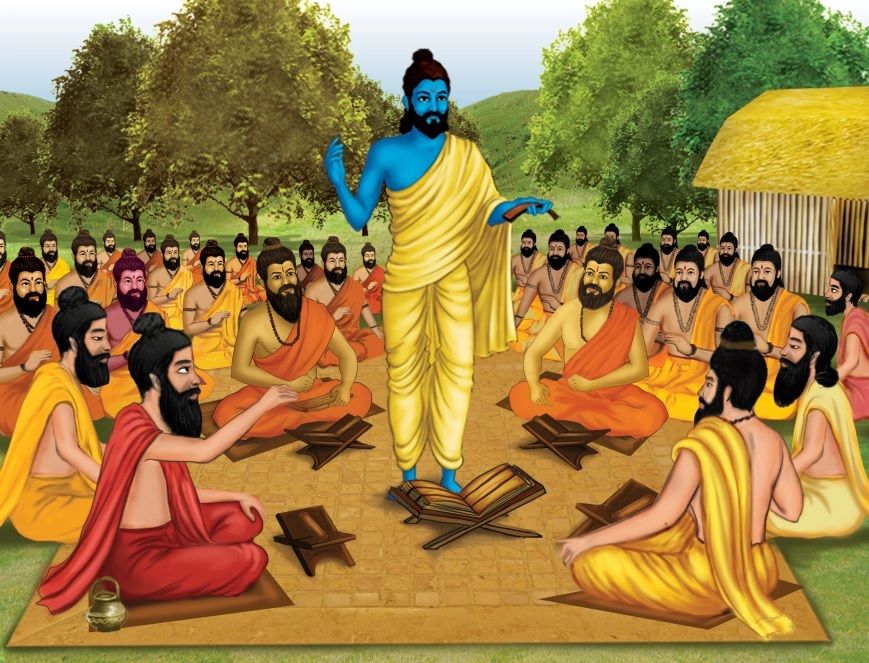If you have read the Vedas or enjoyed contemplating the Upanishads, consider yourself blessed. You are not reading the works of one single individual. The book you hold in your hands results from countless sages working together across thousands of years. How is the work preserved, and how does it read like the work of one person? We can thank the lineage of various sages because the lineage collectively works to fulfill their duty toward their guru, society, and the divine energy. Today’s story deals with the lineage of Bramharishi Vashishta and how they were responsible for preserving the Vedic tradition.
In Sanatana Dharma, we define a rishi as a person who is chaste, stays in severe penance, controls his desire and sense organs, who is a speaker of truth, and has power to reward or punish. — Saptarishis — SA Padmini
Those who attain the highest level of knowledge are known as Bramharishis. Then you have Maharishis and rishis. Women are called rishikaas, and 27 rishikaas are mentioned in the Rigveda.
Bramharishi Vashistha was the mannasaputra (son created out of the mind) of Lord Bramha. Bramharishi Vashistha performed severe penance and lived an austere life in his hermitage. He constantly chanted the name of the divine and played a crucial role in Indian history by being the guru of the Ikshvaku Lineage into which Lord Rama was born.
One day Bramharishi Vashistha’s son Sakti was walking in the woods when a demon named Kalmashpada killed him. The demon then rampaged through the sage’s ashram and killed everyone present. The sage was not present in the ashram, and his grief knew no bounds when he saw the bodies of his sons. He ran to the river near his ashram and threw himself into it, intending to drown and end his misery. The river split into a thousand streams, and Vashishta heard a divine voice instructing him to return to the ashram. Bramharishi Vashistha returned to see his wife, Arundhati, and his daughter-in-law Adrushyanti. His daughter-in-law was pregnant, and he could hear echoes of the Vedas from her womb. This child was the sage Parashara.
Sage Parshara grew up as a mighty scholar of the Vedas and scriptures. The Dwapar Yuga was ending the Kali Yuga was starting. The Vedic knowledge has spread as far as Afghanistan and Burma, but it had become too scattered and unwieldy. The kings were drunk with power and did not respect the brahmins, who had also lost their way and fallen to corrupt practices. Sage Parashara knew he had to coordinate between the Bramhatej (dharma of brahmins) and the Kshatratej (dharma of Kshatriyas) to ensure the Vedic culture was preserved in Kali Yuga. He traveled across the country, met kings, and established hundreds of ashrams. He was immensely respected but also made a ton of enemies. On one occasion, his ashram was attacked, and he was grievously hurt. He walked with a permanent limp after that incident. Parashara knew that he alone could not complete his task in his lifespan, and that job would fall into the lap of the next one to join his lineage. The story has multiple versions at this point.
In one version, Sage Parashara was injured during an attack, and the local fishermen rescued him. He was placed under the care of Matsyagandhi, and she bore him a son Krishna Dvaipayana, also known as Ved Vyasa.
In the second version, Sage Parashara met Matsyagandhi when he wanted to cross the river and saw that it was foretold that she would bear him a son who would complete his mission. They mated on an island, and he walked on water to complete his journey. Thus, Krishna Dvaipayana got his name because Krishna means the one who attracts, and Dvaipayana means “island born.” From this point onward, we will call him Ved Vyasa because he was given the title for successfully compiling the Vedas.
Ever since Ved Vyasa could speak, he started enquiring about his father. He heard stories of his father’s mission and greatness, and a great desire filled every pore of his heart. He wanted to continue and complete his father’s task. Thus at the tender age of six, when his father came to visit them, he soaked in all the knowledge his father offered and asked to become his disciple so he could travel with him. Sage Parashara was reluctant but was finally won over by Ved Vyasa’s commitment and devotion.
By the time Ved Vyasa was sixteen, he was a person of towering intelligence. Until this time, the Vedas had been transmitted orally from one generation to the next because the rishis understood the importance of sound and how pronunciation was critical to Vedic transmission. When the Gangetic plain went through a drought of fourteen years, Vyasa saw people had forgotten to recite the Vedas and decided to write them down. He secured the patronage of King Shantanu, who had married his mother, Matsyagandhi, now called Satyavati. The king performed powerful practices such as the Vajapeya Yagna, Rajasuya Yagna, and Ashwamedha Yagna to cement his status as the emperor. Ved Vyasa chose Kurukshetra as the venue for the Vajapeya Yagna and used it as the opportunity to invite the most eminent sages of India to one location. He then got the Kuru Dynasty to commission a project for compiling the Vedas in a structured collection. Bhishma sponsored this project after King Shantanu’s death. Ved Vyasa assumed the role of the chief compiler, and the project went on for twelve years, thus restoring Kurukshetra to the status of Dharmakshetra.
Thus, you can see how the lineage of Bramharishi Vashistha, who was present during the Treta Yuga, worked through the Dwapar Yuga to codify the Vedas and present it to us.
There are numerous examples of lineages in Sanatana Dharma, including Adi Shankara and Nath Yogis.
Applying Wisdom At Work
Did you know that in the United States, the average lifespan of a company is only 10–15 years? Only 1000 companies have survived 100 years. This number is less than 0.5% of US companies. If you are running a successful business with a robust future, one of the biggest mistakes you can make is not focusing on succession planning. Choosing the right successor to continue running your business is the most essential act in the second half of your career.
Before we look at corporates, let’s look at the impact of succession planning in the billionaire families of Cornelius Vanderbilt and John D Rockefeller.
Cornelius Vanderbilt built a fortune on railroads and shipping during the mid-1800, which should have been worth over 200 Billion based on today’s estimates. Yet his children- mainly his grandchildren- lived lavish lives, built huge mansions, and did nothing to preserve their fortunes. By the 1970s, the family held a reunion with 120 members attending, and there wasn’t a millionaire among them. Meanwhile, John D Rockefeller created a prominent foundation, and his future generations still live a very comfortable life because they planned how to manage their finances.
A recent example of bad succession planning in the corporate world is when Bob Iger had to return to Disney because his handpicked successor Bob Chapek was an absolute disaster and Disney completely lost its way under him.

A successful example of a company doing a stellar job in succession planning was Microsoft choosing Satya Nadella as the CEO. Listen to this fascinating interview where Satya talks about how he was given feedback that he was not hungry enough to be CEO. He also details how, under his leadership, Microsoft went from being a nobody in the cloud business to a significant player. Microsoft bet on Satya despite being a relatively newer entrant because he demonstrated how to grow a high volume, low margin business with Microsoft, which traditionally frowned upon such initiatives.
Why is it such a struggle for people to manage money and find the right candidate who prioritizes the long-term health of organizations? Laurie Santos, who runs the Comparative Cognition Laboratory at Yale, thinks we are hard-wired to make decisions driven by short-term gain. Watch this video on how she trained monkeys to trade and watched them make the same stupid decisions that humans made in stock markets.

Spiritual Lessons from This Story
My Spiritual Guru, Om Swami, places tremendous importance on spiritual lineage. He says that just like his guru Naga Baba who was connected to multiple lineages, he himself has combined the offerings of multiple traditions available across Sanatana Dharma to create a unique and beautiful, and divine route that is now the lineage of Om Swami.
One of the primary roots of my Guru Om Swami’s lineage is in a mantra that Lord Vishnu gave to Ma Laxmi that would allow her and anyone else to remain permanently the devotional sentiment of Lord Vishnu. The mantra was transmitted to Sanatkumar, and Lord Vishnu gave it to Narada, who then passed it on to select disciples.
The lineage also has roots in a mantra Lord Shiva gave to the divine mother, Parvati, for absolute detachment. This mantra was then given to the highest practitioners of Tantra. Thus, it was transmitted to Parashara Rishi, who extracted from the Atharva Veda and gave it to Ved Vyasa.
The mantra got split into two parts, one for Shiva and the other for Devi. Baba Chandradev, the son of Guru Nanak Dev, took the mantra of Shiva and set up a lineage called the Udasin Sampradaya.
My Guru Om Swami’s lineage is the confluence of all these traditions I just described. In the following videos, you can listen to Swamiji talk about the importance of lineage and why its key to spiritual success. I don’t even want to write about it because my words can never do justice to his narration.

In summary, we belong to a tradition thousands of years old and an unbroken lineage of teachers who gave their blood and energy to maintain the purity of the tradition. We are blessed to live in times when we can use applications like Sadhana and Black Lotus to practice Sadhana and Meditation. Let’s make the best use of that opportunity.
References
https://isha.sadhguru.org/in/en/wisdom/article/veda-vyasa-compiler-of-vedas









Comments & Discussion
27 COMMENTS
Please login to read members' comments and participate in the discussion.